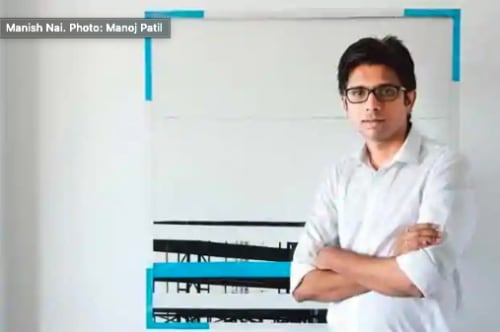Son of a jute trader and hailing from the traditional nai (barber) community, Manish Nai graduated from the LS Raheja School of Art, Mumbai, in 2000, choosing the medium of watercolours in his final year. Many fine nuanced portraits later, his watercolours became more and more abstract. It was only natural, he says, that he came to jute. There was so much lying around as he helped in the family business.
He started by stretching jute directly on to a stretcher, gluing on butter paper, and then layering over with similar alternate layers. On this, he painted abstract compositions; a predilection to geometry, balance and the muted colour palette were already visible in these works.
Can his work be dismissed easily, as craft? Aided, as he is, by computer drawings and projections on to canvas, what is his artistic contribution? These are legitimate questions, but Nai’s jute canvases are impossible to classify as craft. Conceptually they are multivalent; drawing on art history, sound technique, and a process that draws from draughtsmanship, artisanship, Photoshop, projection on to the canvas. This is conceptual art using old technique and new technology, in a rigorous, formal examination of minimal form and structure. This laborious marriage of ways, the organic with the digital, stands as his unique practice. There’s no added stitch here, but a studied reductiveness of material to gain the final image.
Jute kept seeking him out through his artistic journey. In 2008, he made his first experiment with jute sculpture, choosing the simplest form, the cube. Compressing layers of jute fabric into a wooden cube mould, he poured water and with continuous pressure, feeling it viscerally in his gut, compacted the jute into a solid cube. He observed this initial experiment for a year. It held; in composition, in different seasons at different temperatures, in India and in Germany, where the works were exhibited. And Nai knew then that he could take it further—the dimensions, materials and resulting texture were exciting.
For the Art Basel Hong Kong next month with Galerie Mirchandani + Steinruecke, in a solo booth curated by Girish Shahane, Nai has extended these cubes into multiples—in pillars and walls, the building block remains the same even as he expands into different materials like sponge, burlap, concrete and newspaper. A cube is light or heavy, the scale deceptive, the form rigorous—rising from the floor, Brancusi, Bourgeois inform, even as Mumbai’s shanties and booming construction provide the material.
Photographs taken of the patina of old walls, or the raw semi-construct of walls being built, fi ll the photo bank from which he draws inspiration. Using the forming patina of these walls, Nai draws out a myriad of forms. In 2006, his canvases became more layered so that he could achieve this palimpsest of patina. Pulling out the warp he creates areas of gradations that then bring glimpses of the layer below, much like peeling paint does, invoking past histories through loss. Yet loss it isn’t, as the work takes on a pixelated pattern—a simple circle or more complex forms. The subtle three-dimensionality thus achieved, in millimetred depth, seems like the first etching of a trace in a cave wall-relief sculpture.
It’s this manipulation of drawing on a planar surface that caused the shift to the next body of work. Finding the canvas’ boundaries limiting, Nai worked with drawings on the computer and then transferred them straight on to the wall; the small, layered pixels in swirling forms are miniaturized into the tiniest of painted dashes that expand outward. Stand back, and you perceive them as little puck marks on the wall. In his sketchbook, there are violent anarchic scribbles; in the conversion through the computer, these drawings are almost neutered into serenity by pixellation. Flushing out the recesses of his mind, Nai pulls patina, scratches and drawing into one subtle entity.
In the jute canvas and in the painting on wood, he brings his minute wall pixellations back into the frame, but manages to retain expansiveness within the boundaries—there’s still a sense of the infinite; even as you come close to observe the plucked out voids or the scratched paint, the image, reminiscent of Jackson Pollock, remains an ordered Nai anarchy.

